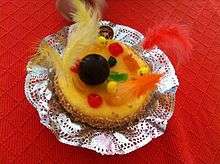Easter mona
The Easter mona (Catalan: Mona de Pasqua; Spanish: Mona de Pascua) is a kind of cake that is usually eaten in Easter or Easter Monday in the Spanish regions of Catalonia, the Land of Valencia and Murcia.[1]

.jpg)

Origins
According to Catalan Costumari by Joan Amades, the mona is already mentioned in the 15th century,[2] though in the dictionary Gazophylacivum Catalano-Latinum, by Joan Lacavalleria, published in Barcelona in 1696, mona has still just a purely zoological definition (monkey is also mona in Catalan). But the dictionary of the Royal Spanish Academy, already offers in its edition of the year 1783 the following definition: "Catalonia, Valencia and Murcia. The cake that is baked with eggs in her shell by Easter, that in other parts of the Iberian Peninsula call Hornazo".[3]
There are several hypotheses about the origin of the term and the tradition:[4][5]
- Munda: in the Latin plural of mundum, banners offered by the Romans to Ceres during April, containing candy and decorating.
- Mûna: in ancient Arabic, land lease taxed on species with cakes, boiled eggs and other agricultural products; it means gift or provision of the mouth.
- Munichia: celebration dedicated to Artemis in ancient Greece.
- Pascorals: feasts that Roman shepherds celebrated with cakes.
- Beltane: Celtic festival that was celebrated in the month of May and where tortillas with eggs were consumed.
Production and varieties
Currently, there are different types of mona, although previously generally they were round. Initially, the mona was a cake made with sugar and other goodies, with hard boiled eggs on it, but in most parts of Catalonia (not in the Land of Valencia and Murcia, where has preserved more or less purely the traditional recipe) over time the eggs turned chocolate and eventually became the basis of the mona. In the Land of Valencia and Murcia, on the other hand, it has not evolved and still has the original form of a brioche with the hard-boiled egg on it.[5]
Currently in the Land of Valencia the Easter mona can be found with a hard-boiled egg on top or with an egg-white caramel, which is cooked jointly with the mona. In the Land of Valencia there are places where the mona is typical all year, without the hard-boiled egg on it, and can be given names such as tonya, panou, socarrat bread, coca bova and other names.[5]
The traditional mona, in Catalonia, is generally shaped like a cake. There are simpler varieties made of sponge cake, gem, chocolate, etc., in the form of a cake with the eggs, supported by a few strips of sponge cake - so in this case it is cooked together in the oven. The presence of the Easter egg is present throughout Europe, from England to the Ukraine, as a symbol of the fertility and the multiplication of the species.[6]
Tradition
In almost all Catalonia and the Land of Valencia, it is customary for the godparents to give the mona to their godchild on Easter Sunday. On Easter Monday, it is a tradition for families or a group of friends to gather together and to go somewhere, specially to the countryside, to eat the mona. Traditionally, the mona had as boiled eggs as years was the child, until he was 12 years old. Currently, is usual that godparents give the mona to their godchild during all life.[5]
The Easter mona tradition is paired with that of bakers, who make authentic architectural works with chocolate, and since the mid-nineteenth century, mones have lost their initial simplicity, making their presentation more complicated, for it must be enriched with caramelized sugar, sugar almonds, jams, crunch, silver anise and, of course, painted Easter eggs; all crowned by figures of porcelain, wood, cardboard or fabric.[5]
References
| Wikimedia Commons has media related to Mona de Pascua. |
- "Twenty things you didn't know about the Mona de Pasqua". Barcelona City Council. Retrieved 12 April 2020.
- "The Easter 'mona' cake: what does the custom signify and where does it come from?". Barcelona City Council.
- "LA MONA DE PASCUA (siglo XVIII, Barcelona, Murcia y Valencia)".
- Costa, Roger (2014). "D'on prové la tradició de regalar la mona de Pasqua?". Sapiens (in Catalan).
- "La mona de Pasqua". Festes.org (in Catalan).
- "Four different kinds of mona for our most deeply-rooted Easter tradition". Barcelona City Council.